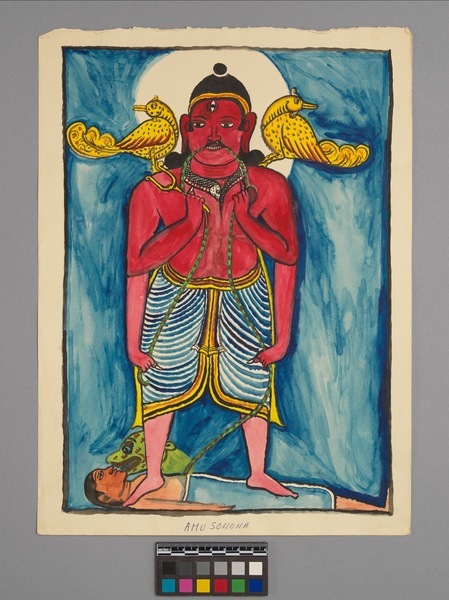Amu Sohona Item Number: 3392/18 from the MOA: University of British Columbia

Description
A watercolour painting which depicts a spiritual being with two birds perched on its shoulders. The being has red skin, three eyes, and four arms. It is wearing a blue skirt which ends just below the knee. The bottom of the skirt has a border made up of brown, yellow and black horizontal stripes. The main body of the skirt is covered in thinner horizontal stripes, and consists of two pieces which come together in the front. A piece of fabric hangs down from the waist. The being is wearing a snake-like creature around its neck as an adornment. It has half-moon shaped eyes, a small mouth, and stretched earlobes that extend down to its chin. Its hair and moustache are black. A portion of its hair is pulled up into a round ball on top of its head, and the rest hangs down to its shoulders. A yellow bird sits on each of the being's shoulders, looking outward. The birds have long, curly tails, wings with red edges, and black spots across their bodies. Between the being's teeth is a long green strand which connects to a green, disembodied head at its feet. All four of the being's hands are holding onto the strand, and one of the hands is also holding a y-shaped object. The being is standing on top of a prone human body. The body has brown skin, and is wearing a long blue skirt. It is lying on its back, and its arms are stretched out by its sides. The painting's background is blue, and a rectangular black border surrounds the image. There is a rounded, unpainted section behind the being's head and shoulders.
History Of Use
The imagery is possibly associated with ritual healing in Sri Lanka. The set of watercolours (3392/3-34) is said to depict spirits that inhabit planets, or deviyo (minor gods) or rakshas and yakkas (evil or mischievous beings). These beings are often depicted in masked dances and exorcisms.
Iconographic Meaning
Identified as a Raksha (demon)/Yakka; mischievous or evil.
Narrative
The collector, Dr. Michael Egan, wrote his doctoral thesis on healing rituals in Sri Lanka. His fieldwork was carried out in the south of Sri Lanka, in the village of Kadurupokuna (Hambantota District), between Sept. 1965 and Nov. 1966.
Item History
- Made in Sri Lanka between 1960 and 1966
- Collected between 1965 and 1966
- Owned by Michael John Egan before 1977
- Owned by Carol Egan before October 2, 2019
- Received from Carol Egan (Donor) on October 2, 2019
What
- Name
- Amu Sohona
- Identification Number
- 3392/18
- Type of Item
- painting
- Overall
- height 37.1 cm, width 27.4 cm
Who
- Culture
- Sinhalese
- Previous Owner
- Michael John Egan and Carol Egan
- Received from
- Carol Egan (Donor)
Where
- Holding Institution
- MOA: University of British Columbia
- Made in
- Sri Lanka
When
- Creation Date
- between 1960 and 1966
- Collection Date
- between 1965 and 1966
- Ownership Date
- before 1977 and before October 2, 2019
- Acquisition Date
- on October 2, 2019
Other
- Item Classes
- paintings; works on paper
- Condition
- good
- Accession Number
- 3392/0018